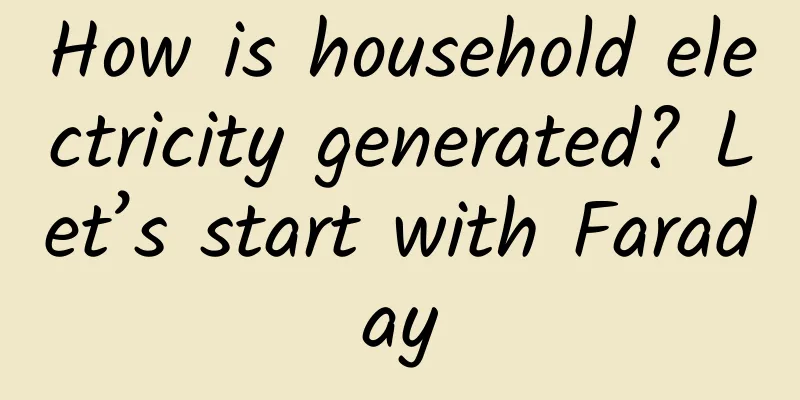How is household electricity generated? Let’s start with Faraday

|
We cannot live without electricity every day, and we also know that household electricity comes from power plants. But how do power plants generate electricity? Who was the first to discover this principle? To understand this, we must first start with a person - Faraday. 1. Electromagnetic induction phenomenon After Danish physicist Oersted discovered the magnetic effect of electric current, British physicist Faraday thought: since electric current can generate magnetic field, then conversely, can magnetic field generate electric current? Because in Faraday's time, people used voltaic cells made of zinc, copper and salt water to use electricity. This kind of battery is difficult to make, has a low voltage, and the electricity it generates is not suitable for ordinary people. However, the magnet resources in nature are very rich. If magnets are used to generate electricity, then electricity can enter thousands of households. Faraday conducted arduous experiments for this ideal. His initial idea was to put a magnet in the solenoid and expect the circuit to generate current, but he never succeeded. Finally, in 1831, Faraday's experiment made a breakthrough. He found that current would only be generated in the circuit when the magnet was inserted or pulled out of the solenoid. We can use modern methods to equate Faraday's experiment to the above situation: connect an ammeter to a solenoid, and when a magnet is inserted into the solenoid, the ammeter will produce a reading. Moreover, the faster the insertion speed, the greater the deflection of the ammeter pointer. Similarly, when the magnet is pulled out of the solenoid, the ammeter pointer will also deflect, but in the opposite direction. However, if the magnet remains stationary in the solenoid, no current will be generated in the circuit. Faraday finally understood that magnets can only generate electric currents when they are in motion and change. Faraday summarized his findings into five cases, among which the case used in modern generators is that conductors that cut magnetic flux lines in a magnetic field can generate electric currents. For example, if we connect a wire to an ammeter and move the wire to the right, the wire will cut the magnetic flux lines like a knife, and current will appear in the circuit. We can also use the right-hand rule to determine the direction of the current: if the magnetic flux lines pass through the palm of the right hand and the thumb points in the direction of the wire movement, then the direction of the four fingers of the right hand is the direction of the generated current. According to this principle, Faraday made an early generator, but the British Chancellor of the Exchequer was skeptical about the use of the generator. He asked Faraday: Your invention is interesting, but what is its use? Faraday said: Sir, perhaps you will be able to tax it soon. Sure enough, electricity has now become an indispensable part of our lives. Who doesn’t pay for electricity? 2. Direct current and alternating current Early generators produced direct current, which is a current whose direction does not change. Today, our household electricity is alternating current, which is a current whose direction changes periodically. Specifically, one wire in a two-hole socket is called the "neutral wire". The voltage of the neutral wire is the same as the earth, so touching the neutral wire will not cause electric shock. The other wire is called the "live wire". The voltage of the live wire is sometimes higher than the earth and sometimes lower than the earth. Since the current flows from high voltage to low voltage, the current sometimes flows from the live wire through the electrical appliance and then flows back to the neutral wire, and sometimes flows from the neutral wire through the electrical appliance and then flows back to the live wire. Each cycle is 1/50s, which is called 50Hz alternating current. The biggest advantage of alternating current over direct current is that it is very convenient to change the voltage, so that high-voltage transmission can be carried out to reduce losses. So, how is this alternating current generated? Alternating current can be generated by a coil rotating in a magnetic field. For example, in the following situation: when the coil rotates, the right wire moves upward, and according to the right-hand rule, the generated alternating current flows from c to d; the left wire moves downward, and the generated alternating current flows from a to b, so the current in the entire circuit flows in the direction of cdab. The outer end of the coil is connected to the external circuit through two brushes, so that the current can flow from top to bottom through the brushes through the light bulb. After half a cycle, the coil rotates half a circle, ab and cd exchange positions, and the current direction becomes badc. In this way, the current will flow through the bulb from bottom to top. Thus, alternating current is formed. If the coil rotates at a constant speed, sinusoidal alternating current is formed. In other words, as long as the coil and the magnet can rotate relative to each other, current can be generated. In modern generators, it is not the coil that rotates, but the magnet, called the "rotor". The coil is stationary, called the "stator". At the same time, due to the needs of the engineering company, the generator coil has three groups, and any two groups of coils are at a 60-degree angle. In this way, when the magnet rotates at a constant speed in the coil, three sinusoidal alternating currents are generated in the three groups of coils, and each one lags behind the previous one by 1/3 cycle. These three alternating currents will have a common zero line (neutral line) and different live lines (output lines). When supplying power, if we connect a live line and a zero line to an electrical appliance, it will be household electricity 220V. If we connect two live lines to an electrical appliance, it will become industrial electricity 380V. So, how can we make the coil or magnet rotate? This depends on the type of generator. Hydroelectric generators use the impact of water to make the turbine rotate, wind turbines use fan blades to make the generator rotate, and thermal generators use combustion to heat water vapor to drive the turbine. This process requires the consumption of external energy. In short, a generator is a machine that converts other forms of energy into electrical energy. After the invention of the generator, various electrical appliances emerged like mushrooms after a rain, and mankind entered the electrical age. 3. A scientific master who never went to school We have to talk about Faraday again, the man who brought mankind into the electrical age. Faraday was born into a blacksmith family. Due to his family's poverty, he dropped out of elementary school after only two years and became an apprentice to a bookbinder. However, this job allowed him to come into contact with a large number of books and various documents that ordinary people could not access, and he was deeply fascinated by science. With the help of an old customer in the bookstore, the 20-year-old Faraday had the opportunity to listen to the speech of chemist Davy. He also wrote a letter to Davy with the organized speech records and expressed his willingness to devote himself to science. After reading Faraday's resume, Davy said to him: "Young man, let me tell you that science is very hard and there is not much reward." Faraday replied: "I consider science its own reward." Davy was moved, and Faraday finally became an assistant in Davy's laboratory. His scientific dream became a reality from Davy's laboratory. Later, Faraday made amazing achievements in physics and chemistry and became the greatest scientist of that era. Faraday was also a man of high moral character. Due to his early experiences, he attached great importance to the training of young scholars and encouraged a group of scientific masters such as Maxwell. He refused to be knighted, refused to become the president of the Royal Society of Science twice, and expressed his unwillingness to be buried in Westminster Abbey, the resting place of Newton and others. Therefore, people buried him in other cemeteries, but erected his monument next to Newton's tombstone in Westminster Abbey. By the way, his mentor, David, was also a famous chemist. People believe that David's greatest contribution was the discovery of Faraday... Source: Mr. Li Yongle |
<<: Do you know the three functions of coffee?
>>: If you pinch a tiger by the scruff of its neck, will it become as obedient as a cat?
Recommend
Dismantle the virtual resource project operated through Baidu bidding. Mom can also operate it at home and earn 15,000 yuan a month
I have been operating this project for more than ...
150 million years ago, this oldest bird rewrote the history of bird evolution! What is the relationship between dinosaurs and birds?
Recently, a bird fossil named Baminornis zhenghen...
Yulin Mini Program Development Company, how much does it cost to develop a supplement mini program?
How much is the quotation for Yulin supplement de...
Android learns to visualize database operations in one minute (no ROOT required)
When I first started working with the Android dat...
The higher the alcohol concentration, the better the disinfection effect? This statement is really wrong!
When it comes to medical alcohol, everyone is fam...
WeChat’s new rules are here! Mini-programs will need authorization to access personal sensitive information
With the rapid development of technology, a varie...
Jian Yang's "Wanjian Guizong Daily Limit Strategy" stock trading tutorial video
Jian Yang's "Wanjian Guizong Daily Limit...
The essence of brand operation, using F4 to crack Steve Jobs' reality distortion
Today we are going to talk to you about how brand...
Another new energy vehicle is "hot"! How should I choose a car?
In recent years, with the popularization of new e...
Is the spacecraft online? The "Clairvoyance" tracking and control radar reports
"Jiuquan radar tracking is normal!" ===...
Kuaigou Taxi's customer base tripled, was the brand name change a success?
Do you still remember Kuaigou Taxi, which grabbed...
Game CP attention! New regulations from the Ministry of Culture: Props content must be made public, lottery rules strictly regulated
On the evening of December 5, the Ministry of Cul...
When operating short videos, don’t fall into these pitfalls!
People often say "avoiding pitfalls is progr...
How to place Tik Tok ads?
What are Douyin advertising marketing resources? ...
Brand marketing methods in 2020!
In this fragmented era, in the context of decentr...









